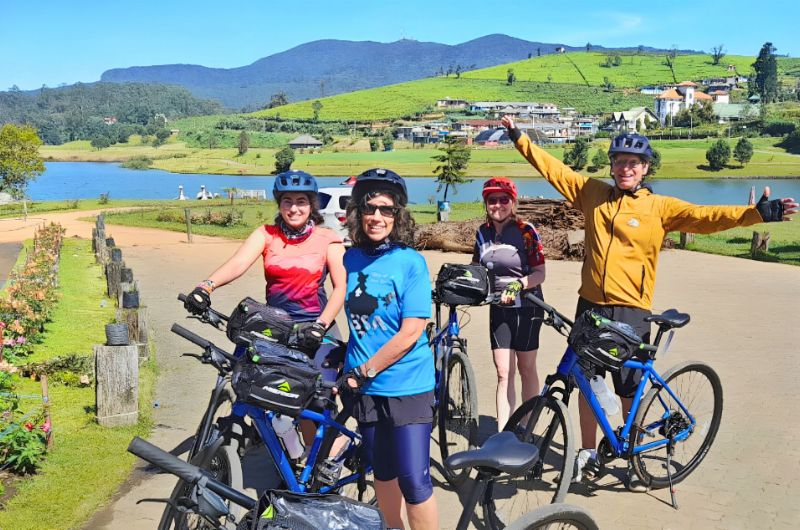Embarking on a journey to Sri Lanka can be an exciting whirlwind of anticipation and curiosity. As you weave through the excitement of planning, countless questions may dance in your mind. What's the visa situation? Is it a safe country to travel to? What are the food and people like? And, of course, the universal traveler's query - do they speak English?
In this Sri Lanka Travel Guide, get ready for an enlightening expedition where we spill the details (perhaps a cup of Ceylon tea?) on everything you need to know before immersing yourself in the allure of this captivating island nation.

Sri Lanka Entry Requirements
Planning a trip to Sri Lanka is an exciting venture, and to ensure your journey is as smooth as a sip of Ceylon’s finest, let's dive into the essential details of entry requirements.
So, do you need a visa to travel to Sri Lanka?
Yes! Everyone traveling to Sri Lanka needs a visa. Luckily, the process of applying is very quick and easy.
According to the Sri Lanka ETA website you are not permitted to arrive in Sri Lanka until you receive the ETA Approval Notice, although, the ETA Acknowledgement Notice will not serve as entry approval for your arrival in Sri Lanka.
You can apply for an Electronic Travel Authorization (ETA) online here.
We recommend checking the official Sri Lanka ETA website for the most up-to-date information.

What’s the weather like in Sri Lanka?
Sri Lanka boasts a year-round invitation to paradise, offering diverse climates across the island. March to mid-April is the sweet spot for sunshine, marking the driest period nationwide. Temperatures range from 81-91°F (27-33°C).
From late May to September, the first seasonal shift brings a lush transformation to the southwest lowlands and central hills. Vibrant green landscapes and comfortable temperatures between 79-90°F (26-32°C) create an inviting ambiance, with the added benefit of fewer tourists, making your exploration more intimate.
As the second seasonal change unfolds from November to February, the northeast experiences gentle showers that don't last long, unveiling a serene atmosphere with temperatures ranging from 75-86°F (24-30°C).
Sri Lanka’s two rainy seasons can often leave travelers confused as to the best time to visit, but it's rarely so dramatic that it stands in the way of a brilliant holiday!
The hill country, on the other hand, is significantly cooler than the northern plains and coast. Here, altitude plays a starring role, with winter months dipping into single-digit temperatures ranging from 41-59°F (15-24°C).
Our favorite time? All the time.

Is Sri Lanka a safe country to visit?
Yes, Sri Lanka is generally considered a safe country to visit. As with any destination, it's good to stay informed about the current situation and travel advisories.
Sri Lankans are known for their genuine smiles and eagerness to help visitors. Whether you're navigating bustling markets, seeking directions, or just striking up a conversation, you'll find a friendly face ready to assist. The hospitality extends to all corners of the island, making you feel not just like a traveler but like a cherished guest.
Like anywhere, it's advisable to take standard precautions such as being aware of your surroundings, securing your belongings, and following local guidelines. If you have specific travel dates or plans, check for any recent updates from reliable sources like your country's embassy or the Sri Lanka Tourism website.
Hear from our guests: Read Alison’s firsthand account biking through Sri Lanka as a solo female traveler.

Money and currency in Sri Lanka
The official currency of Sri Lanka is the Sri Lankan Rupee (LKR). It's essential to note that Sri Lankan rupees are considered a closed currency, meaning you might not get a favorable exchange rate outside of Sri Lanka. To maximize your value, it's advisable to exchange your money upon arrival in the country.
In more urban and tourist areas, credit cards are widely accepted, offering convenience for various transactions. However, carrying some cash is a smart move, especially when exploring rural or off-the-beaten-path locations where card facilities may be limited.
Sri Lanka boasts a well-established network of ATMs in cities and major towns, providing a convenient way to withdraw cash. Ensure that your card is set up for international transactions before your journey, and inform your bank about your travel dates to prevent any potential issues. Keep in mind that VISA and Mastercard are the most widely accepted ATM cards in Sri Lanka.
When dealing with cash, you can exchange your foreign currency at banks and authorized money changers. While some hotels in Sri Lanka may offer money-exchanging services to their guests, it's worth noting that their exchange rates tend to be less favorable.

Should you tip in Sri Lanka?
Tipping in Sri Lanka is not mandatory, but it is appreciated and becoming more common, especially in tourist-centric areas. While it may not be culturally ingrained, giving a tip is a gesture of gratitude for good service.
In restaurants, leaving a 10% tip is generally appreciated, but it's always a good idea to check if a service charge is already included in the bill.
For other services like hotel staff, drivers, and tour guides, tipping is also appreciated. Small gestures of appreciation go a long way in acknowledging good service.
Note: If you choose to embark on one of our Grasshopper Adventure tours in Sri Lanka, you'll be delighted to know that tips for dining and service personnel are included. We've got you covered, so you can focus on savoring the local cuisine and soaking in the culture.

How to Get Around in Sri Lanka?
There isn't a single "best" way to explore; instead, dive into the thrill of trying out various modes of transport. Each option promises a unique adventure, so why settle for just one when you can have it all?
Tuk-Tuks: These three-wheeled wonders are perfect for short distances, offering a quick and lively way to explore cities and towns.
Buses: Hop on a local bus for an authentic Sri Lankan experience. These rides connect cities and rural areas, providing a glimpse into daily life and scenic views along the way.

Trains: No Sri Lankan adventure is complete without a train ride through the picturesque hill country. Sri Lanka's rail network is arguably one of the most scenic in Asia, offering stunning views of tea plantations and mist-covered mountains, making it a must-do for any visitor.
Taxis: For a more comfortable ride, taxis are readily available in urban areas and can be hired for longer journeys. Negotiate the fare before starting your journey, or opt for metered taxis when available.
Rental Cars: If you prefer the freedom to explore at your own pace, renting a car is a great option. Roads are generally well-maintained, and it's an excellent choice for those wanting to venture off the beaten path. Keep in mind that traffic drives on the left-hand side of the road in Sri Lanka.
Domestic Flights: For those short on time or looking to explore multiple regions swiftly, domestic flights connect major cities and popular tourist destinations.
Cycling: And of course, our absolute favorite way, on two wheels. Sri Lanka has lots of small secondary roads, especially in the hill country, which are a legacy of its colonial past. These roads are generally quiet and scenic, and they are a fantastic way to explore the country at its best. Pedal at a leisurely pace, soak in the stunning views, and uncover hidden gems along the way.

What to Do in Sri Lanka
Sri Lanka beckons with a wealth of experiences waiting to be discovered. Here are 5 things you absolutely must do for an incredible adventure:
- Embark on a bike ride through the enchanting countryside, leading you to the ancient echoes of Sigiriya's rock fortress, once ruled by King Kasyapa.
- Ascend Little Adam’s Peak for panoramic views. The climb, suitable for both beginners and experienced hikers, offers the perfect balance of challenge and reward.
- Ride and stroll amidst the lush highland tea plantations, tracing the journey of tea leaves from the earth to your cup.
- Take a Jeep safari through Yala National Park, which boasts the world's highest leopard density. Spotting these elusive creatures adds an extra layer of excitement to your safari adventure.
- Experience the iconic and breathtaking rail route to Ella, an essential journey for any Sri Lankan visit.
Explore the 10 Best Things to Do in Sri Lanka here.

Sri Lanka Food and Drinks
Rumor has it that Sri Lankan food is all about the spice, but don’t confuse spice with spicy. Most dishes are mild but packed full of aromatic flavors waiting for you to explore.
Top 5 Sri Lankan Dishes You Have to Try:
1. Rice and Curry: A quintessential Sri Lankan meal, "rice and curry," is a symphony of aromatic spices, vibrant curries, and various accompaniments. Be ready for an explosion of flavors in every bite.
2. Hoppers: These bowl-shaped pancakes, made from fermented rice flour, are breakfast favorites. Whether plain or egg hoppers, they are crispy on the edges and soft in the center, making them delicious to enjoy on their own and also well suited for soaking up curries

3. Kottu Roti: A popular street food, kottu roti is a delightful mishmash of shredded flatbread, vegetables, eggs, and your choice of meat or fish, all stir-fried with aromatic spices.
4. Fish Ambul Thiyal: A unique and tangy dish, fish ambul thiyal features fish chunks marinated in goraka (a sour fruit) and spices. It's a burst of flavors that tantalizes your taste buds.
5. Pol Sambol: No meal is complete without pol sambol, a coconut relish with chili, lime, and Maldives fish. It adds a spicy kick to your dish and complements the main course beautifully.
Is vegetarian food available in Sri Lanka?
Absolutely! Vegetarian food is widely available in Sri Lanka. The local cuisine offers various meat-free options, including vegetable curries, samosas, and coconut sambol. Whether you dine in local eateries or traditional homes, you'll find a range of vegetarian dishes to choose from.

Top 4 Sri Lankan Drinks You Have to Try:
Now that you've got the lowdown on must-try dishes, pair them with one of these beverages for the perfect complement to your Sri Lankan culinary adventure.
- Tea: Ceylon tea, which the British introduced in the early 18th century, is Sri Lanka's claim to fame. Available in oolong, black, white, and green variations, each type is crafted uniquely. Throughout the country, locals savor their hot brew with a touch of milk and sugar, creating a delightful tea-drinking culture.
- King Coconut Juice: Known locally as thambili, king coconuts, indigenous to Sri Lanka, reign as the ultimate thirst quencher on a scorching day. The refreshing juice extracted from these bright orange coconuts is a cool respite, embodying the essence of the island's natural delights.
- Toddy: Harnessing the coconut palm's bounty, Sri Lankans have perfected Toddy, an alcoholic drink fermented from the sap of coconut flowers. When expert "toddy tappers" harvest the sap, it immediately undergoes fermentation, producing a sweet, milky beverage.
- Arrack: The evolution of Toddy, Arrack undergoes a 24-hour distillation process, elevating its strength to an alcohol content ranging from 60–90%. With a flavor profile akin to rum or whiskey, Arrack stands as the most popular local liquor in Sri Lanka, offering a distinctive and potent beverage choice. Creative mixologists have crafted some delicious locally inspired cocktails out of Arrack, so make sure to try one out if you find it on the menu.

What to pack for Sri Lanka
You're almost off to Sri Lanka, and the key to a seamless journey lies in your suitcase! Sri Lanka's tropical climate calls for light and breathable fabrics. But if you plan to visit the central Highlands, a warmer set of clothes for the evenings is recommended, as temperatures can dip to 55°F (13°C).
For Men: Men can wear shorts and T-shirts, especially in urban and tourist hotspots. However, avoid sleeveless shirts and going bare-chested, as this may be deemed inappropriate in many places, even within popular tourist destinations.
For Women: In tourist hubs like Colombo, Kandy, and Galle, women enjoy more flexibility in their clothing choices. Exercise caution about overly revealing outfits, as this may attract unwanted attention. In less touristy or rural areas, opt for more modest attire like a T-shirt or tunic paired with long trousers or a long skirt. While beachwear is acceptable in coastal areas, modest clothing is appreciated in more conservative regions and religious sites.
Mosques and Religious Sites: When exploring mosques and religious sites, even in tourist-centric cities, it's a gesture of respect to cover your arms. This means wearing clothing that extends to cover your shoulders and upper arms. For women, this might involve using a shawl or scarf to cover the head as well.
Clothes aside, another essential often forgotten about is power adapters. Sri Lanka uses Type D and Type G electrical sockets (230V), so ensure you have the right adapters for your devices.
Lastly, remember to pack sunscreen, insect repellent, sting and bite relief cream, and antiseptic cream for a worry-free adventure.
Tailor your packing list based on the specific activities and locations you plan to explore. Sri Lanka offers a diverse range of experiences, so be prepared for various adventures!
Internet in Sri Lanka
Internet connectivity in Sri Lanka is widely available, especially in urban and tourist areas. You can find numerous cafes, hotels, and public spaces offering free Wi-Fi. Mobile networks provide good coverage across the country, making it convenient to stay connected while exploring.
Consider purchasing a local SIM card on arrival for a cost-effective and efficient way to access data on the go. While remote or mountainous areas may have slightly weaker signals, overall, Sri Lanka provides reliable internet access for travelers.

Culture and Etiquette in Sri Lanka
Much like several other nations in South Asia, Sri Lanka upholds conservative values rooted in its rich traditions. To ensure a memorable stay on this enchanting island, keep in mind the following guidelines:
DO'S
- Greet with Respect: Traditional greetings involve joining your hands together in a prayer-like gesture and saying "Ayubowan" (May you live long). This is a sign of respect, especially for elders.
- Accept and Offer with the Right Hand: When giving, receiving, or eating something, use your right hand. The right hand is considered purer in Sri Lankan culture.
- Remove Shoes Indoors: It's customary to remove your shoes when entering someone's home. The same applies to certain shops and offices.
DON'TS
- Left Hand Gestures: The left hand is traditionally considered less pure. Avoid using it for giving or receiving items, especially when interacting with elders.
- Respect Buddha Statues: Avoid turning your back on Buddha statues, as it's considered disrespectful. While taking photos is acceptable, ensure that everyone in the picture faces the statue. Wearing clothing adorned with images of Buddha or other deities is also discouraged.
- Avoid Comparisons with India: In conversations with locals, steer clear of comparing Sri Lanka to India. Appreciate the distinctiveness of each country's culture and avoid drawing parallels between them.

Religion in Sri Lanka
Religion in Sri Lanka is a vibrant and integral part of the country's cultural identity. The island is home to multiple religions, each contributing to its rich tapestry. The primary religions practiced in Sri Lanka include:
Buddhism: The majority of the population in Sri Lanka adheres to Buddhism, particularly Theravada Buddhism. Buddhist temples, stupas, and monasteries dot the landscape, with significant sites like the Temple of the Tooth Relic in Kandy holding deep cultural and religious importance.
Hinduism: Hinduism has a significant presence, particularly among the Tamil population in the Northern and Eastern regions. Temples dedicated to various deities, such as the Koneswaram Temple in Trincomalee, showcase the diversity within Hindu religious practices.
Islam: Islam is practiced by a sizable minority, primarily among the Moor and Malay communities. Mosques are spread across the country, with notable ones like the Jami Ul-Alfar Mosque in Colombo showing unique architectural styles.
Christianity (mostly Catholic): Christianity, including both Roman Catholicism and various Protestant denominations, is followed by a significant portion of the population. Historic churches, like St. Anthony's Shrine in Kochchikade, reflect the deep-rooted Christian heritage.

Religious festivals and ceremonies play a crucial role in Sri Lankan life, showcasing the harmonious coexistence of diverse religious communities. The country celebrates events such as Vesak (Buddhist), Deepavali (Hindu), Eid al-Fitr (Islamic), and Christmas (Christian) with grandeur, fostering a sense of unity among its people.
While this island is small, celebrations are big. Here are a few things you can expect:
- Poya: On the full moon of each month, Sri Lanka observes a public holiday that is filled with Buddhist festivities. On these days, strict regulations on the sale of alcohol and fresh meat put an end to the regular hustle and bustle of businesses and shops. Entertainment options might also take a back seat during these serene periods.
- Pongal (January): A three-day festival by the Tamil community, marking the end of the winter solstice and dedicated to the Sun god, Surya.
- National Day (February): Celebrated on February 4, Sri Lanka commemorates its independence from the British Empire with nationwide performances, parades, and presidential speeches.
- Maha Shivaratri Day (February/March): A Hindu festival marking the Great Night of Shiva with vigils, chanting, and offerings.
- Avurudu (April): In April, Sri Lanka transforms into a festive haven as Buddhists and Tamils unite to celebrate the New Year. With the celebratory buzz comes a surge in local shoppers on the prowl for gifts and new threads, so plan a bit of extra time for your outings. However, note that on April 13th and 14th, liquor stores and bars are closed.
Languages in Sri Lanka
In Sri Lanka, people speak a mix of languages that reflect their diverse culture. Sinhala, spoken by the majority, and Tamil, used by the Tamil community, are their official languages, each with its own unique script.
English is widely understood, especially in urban areas, tourist destinations, and among those in the service industry. Most signage, menus, and official information are often available in English, making it easier for visitors to navigate and communicate.

Your Adventure Awaits at Handlebar Height
Congratulations! You've just earned your Sri Lanka Explorer badge! Your entry requirements are squared away, you've got a handle on your Roti from your Hoppers, and you've embraced the nuances of cultural etiquette. Now, it's time to toss those essentials into your backpack, clutch your passport, and get ready to be captivated by the enchantment of Sri Lanka.
Let us take care of everything while you explore Sri Lanka on two wheels. Whether you're cruising through tea plantations, encountering wildlife in national parks, or winding through charming villages, the island's diverse beauty awaits.
Intrigued by the idea? Explore our Sri Lanka bike tours.


 By Lirene Cilliers Posted 12th Dec 2023
By Lirene Cilliers Posted 12th Dec 2023







